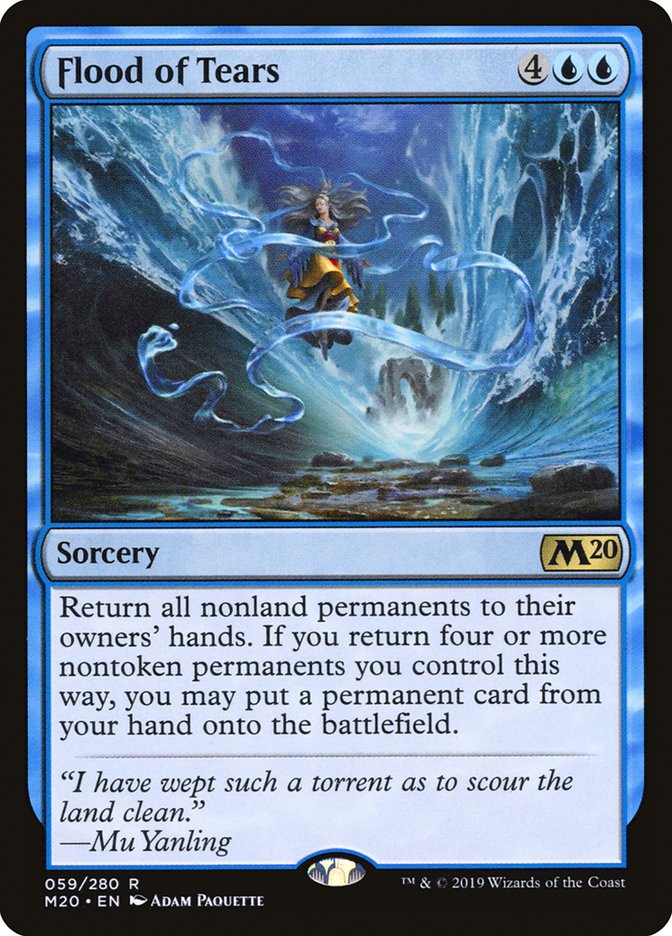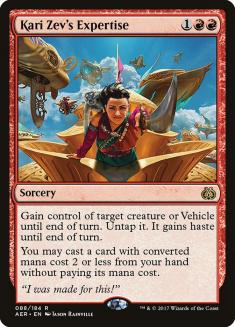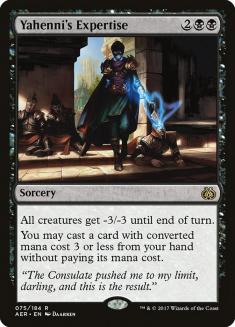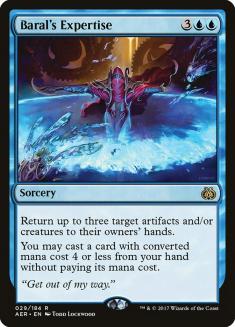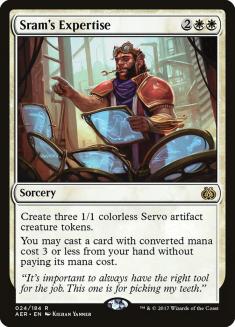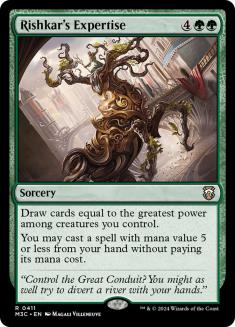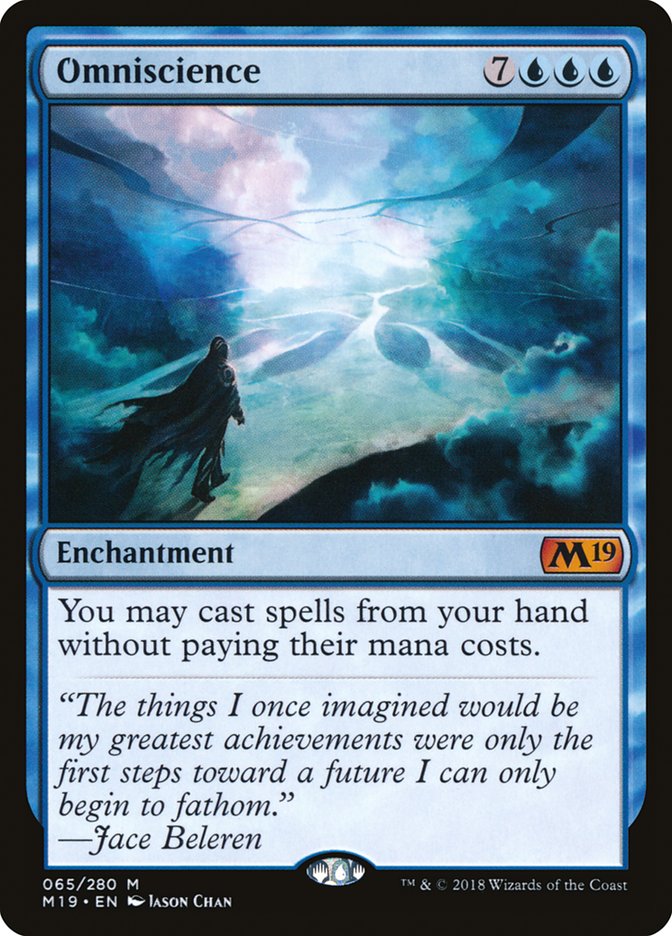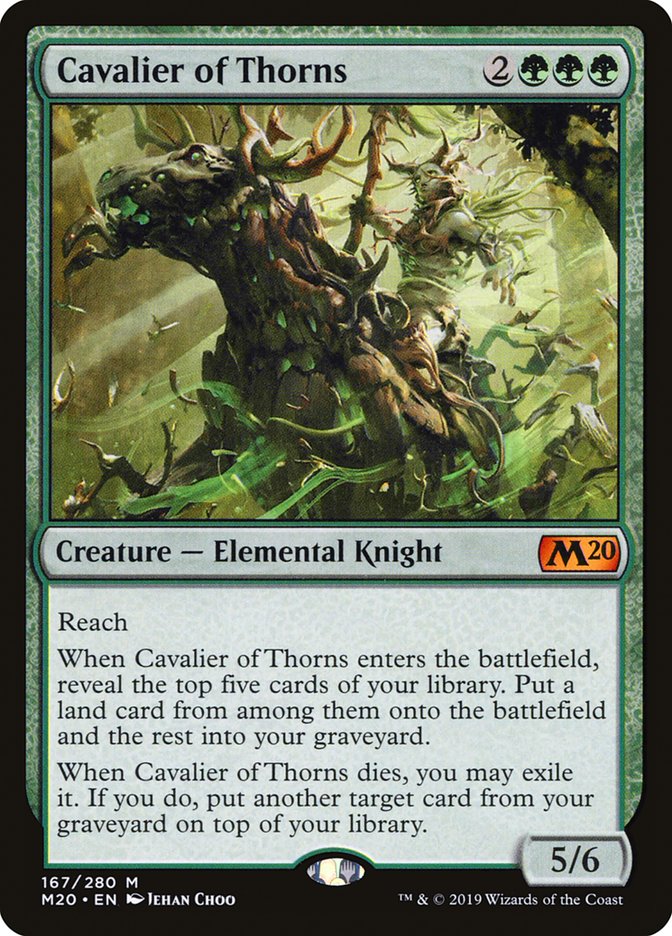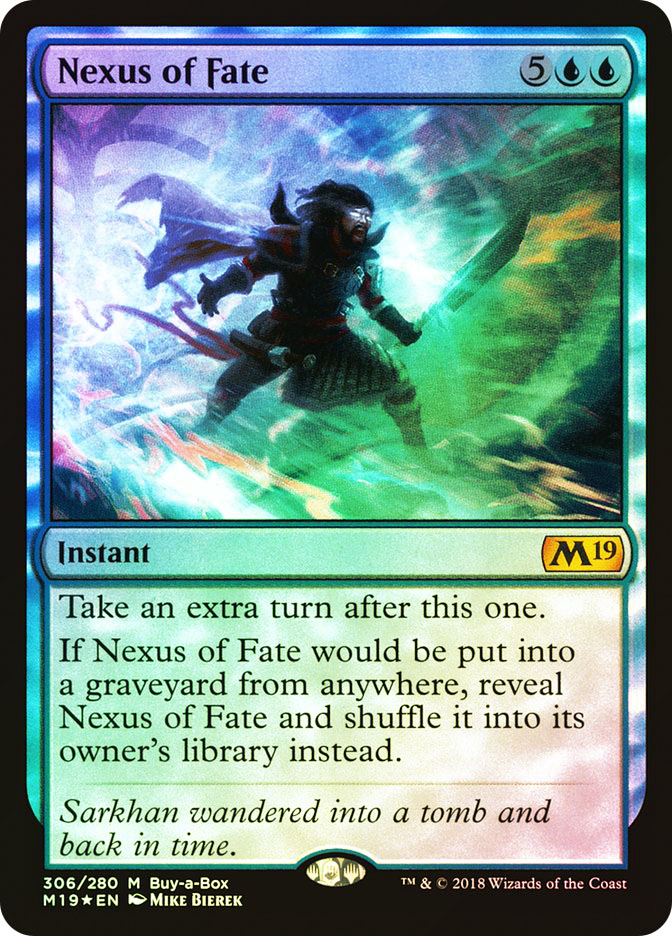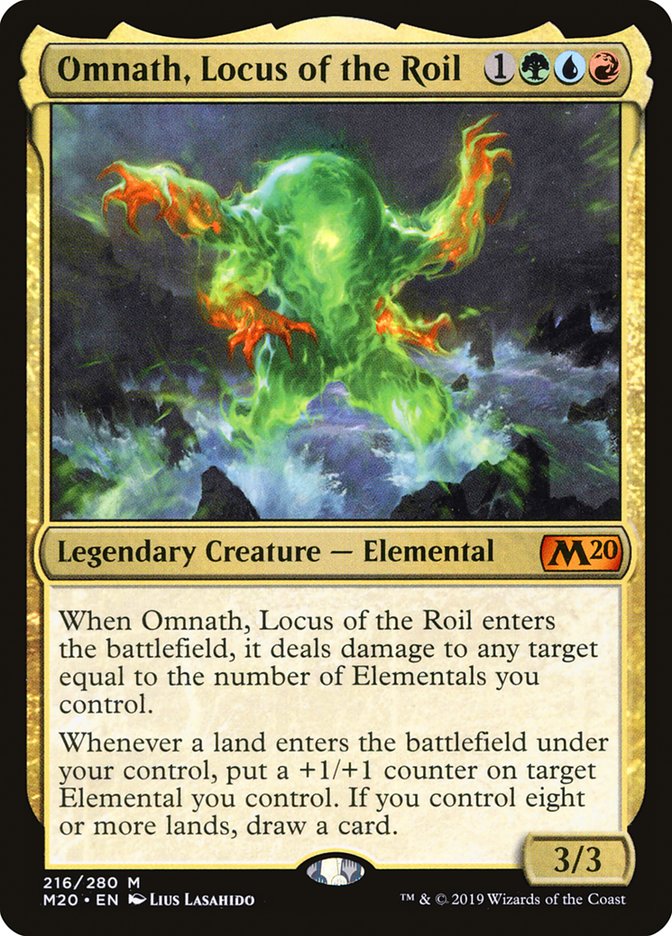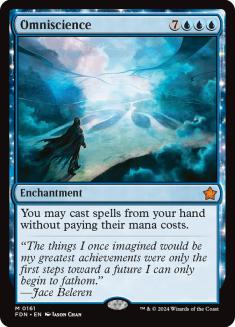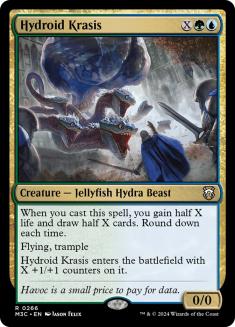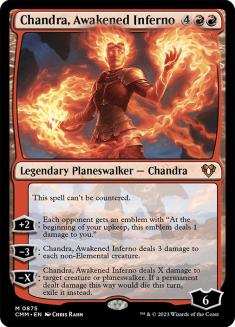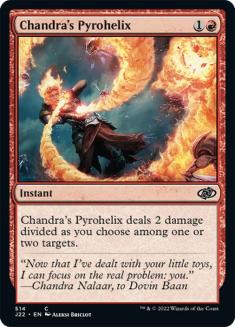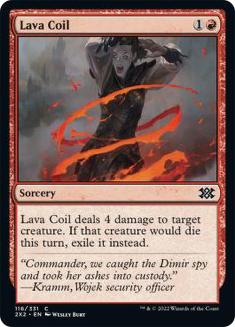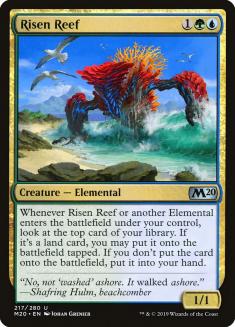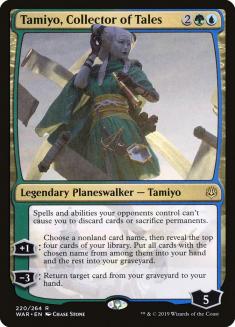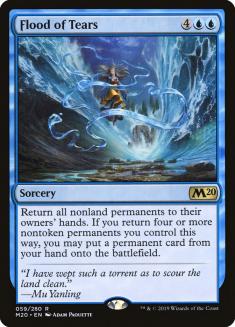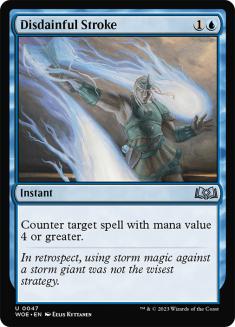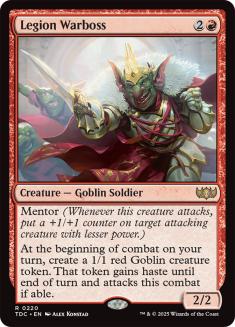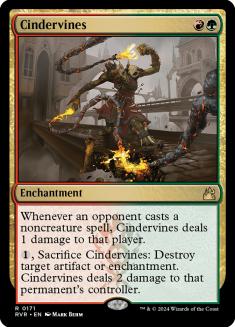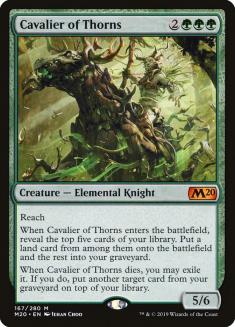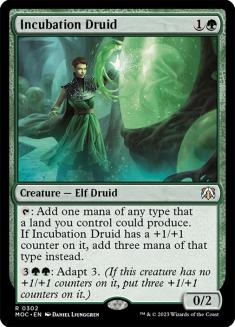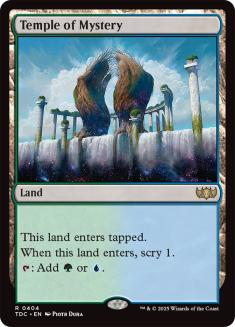With the release of Core Set 2020, I’m trying to return my weekly column to what I consider to be its roots. Theory and Top 10 lists have their place, but I think you’re here for decks. And not just any decks. You want the decks sitting just below the top tier, poised for a breakout weekend. You want the decks that will start up the salt mines on your opponent’s side of the table, leaving them muttering to themselves as they walk away. Maybe you even want the decks capable of bringing your opponents to tears. How appropriate.
I’ve taken to a saying over on the Arena Decklists podcast:
Flood of Tears messes with the rules of Magic in a very real way. Free spells tend to be dramatically overpowered unless they are saddled with restrictions. Recently, access to this type of effect has usually been accompanied with converted mana cost restrictions.
Most of these cards proved to be fine role-players, but their restriction prevented things from getting out of control. When it comes to Flood of Tears, not only are the restrictions gone, being able to bounce all nonland permanents is a powerful effect in and of itself. Just the existence of such a powerful reset button has the potential to invalidate accumulating resources on the battlefield in a fair fashion (think Mono-White Aggro). Surely, with all these things working in its favor, current Standard must be devoid of any truly ludicrous permanent for a payoff.
Oh. Never mind, then. Obviously, the first order of business was to figure how hard I could push this interaction. However, my good friend Yoman5 beat me to the punch and put together a list that had folks talking on Day 1.
Creatures (10)
Planeswalkers (9)
Lands (25)
Spells (16)

Ultimately, this list proved a bit fragile with all the weaknesses you’d expect from a Simic combo deck with zero ways to stem opposing aggression. Not only was disruption a huge issue, but I’d often just die before I did anything relevant.
If the goldfishing approach wasn’t going to work, it was clear that I needed to find a measured plan with some capacity to get on to the battlefield. Thankfully, I knew just the Cavalier for the job.
Since I was consenting to playing something resembling fair Magic, I didn’t want to muck up my hands with an uncastable card in the form of Omniscience. Instead I wanted to find a build that could effectively leverage the additional setup time that a bunch of big bodies and Flood of Tears produced. By relying on Cavalier of Thorns, I had a completely reasonable card to hard-cast that was plenty happy to be bounced and replayed with Flood of Tears. The question was how to leverage all those additional lands I would have without relying on clunky, expensive permanents.
Creatures (23)
- 4 Wildgrowth Walker
- 4 Merfolk Branchwalker
- 4 Jadelight Ranger
- 3 Hydroid Krasis
- 4 Risen Reef
- 4 Cavalier of Thorns
Planeswalkers (4)
Lands (26)
Spells (7)

This deck was (is?) legitimately good… at some things. If you unleashed this Scapeshift deck on several of our previous formats, it would likely be a terror. The problem is that, while it’s adept at brick-walling classic “attacking and blocking” Magic and presenting an ever-expanding Zombie-based end-game via Field of the Dead, it’s not set up for answering opposing cascading advantages such as those generated by Risen Reef. An opponent that mitigated my card advantage engines would eventually leverage their own to find an out to my Zombie horde, whether through battlefield presence, sweepers, or Fogs. If the gameplan was to ignore opposing Risen Reefs, then I needed to find a way to get really big, really quickly.
Creatures (22)
Planeswalkers (5)
Lands (24)
Spells (9)
Sideboard

This was the first spot where I attempted to play Nissa, Who Shakes the World in conjunction with Flood of Tears, and with the absurd mana production enabled by Leyline of Abundance, I was able to start creating windows to just get my opponent dead. I would even occasionally play Omniscience, put every land in my deck onto the battlefield, animate them all, and win on the spot. This deck felt like a possible Tier 1 inclusion, but there was one glaring weakness I couldn’t overlook.
Nexus of Fate had once again begun to pick up steam on Arena, and the matchup was basically hopeless. I had sped up the pace at which I was able to achieve my midrange-ish endgames, but with a bunch of Leylines and mana creatures, my clock was still far too anemic in the face of Root Snares. I needed help, and I knew it would have to come from the addition of a third color. Once I had made this concession, I started to think about cards that could interact with my opponent’s battlefield while simultaneously helping my engine.
Creatures (26)
- 4 Llanowar Elves
- 3 Hydroid Krasis
- 2 Incubation Druid
- 2 Paradise Druid
- 4 Risen Reef
- 4 Omnath, Locus of the Roil
- 4 Leafkin Druid
- 3 Cavalier of Thorns
Planeswalkers (5)
Lands (25)
Spells (4)

With the addition of Omnath, it feels like I’ve come upon the exact right balance for a Flood of Tears deck in Week 1. While Omnath’s damage output doesn’t seem jaw dropping, killing opposing 1/1s matters a ton in current Standard. Llanowar Elves is the most fearsome opener possible, and a Risen Reef that triggers multiple times can feel unbeatable. Omnath gives me a chance to interact without easing off the gas on my own snowball, and in a format of cascading advantages, this is exactly where I want to be. I’m giving up none of the overbearing Flood of Tears end-games, and the Omniscience kill no longer requires an attack step. Most importantly, my sideboard plans against all the top decks in the format feel well-rounded.
VS Orzhov Vampires
Out:
In:
This matchup feels favorable, as their only form of reach is Sorin, meaning Flood of Tears can effectively lock them out of most damage-dealing options. Nissa has some sizing issues here, and while Tamiyo isn’t ideal in mid-game situations, a Flood of Tears lock is the most common end-game. More sweepers and some fine spot removal really shore up things after sideboard.
VS Mono-Red Aggro
Out:
In:
Cavalier of Thorns is just so big. If they ever do invest the resources necessary to kill it, they’re probably miles behind and Cavalier will find a fine option to replace itself in the graveyard. Mono-Red is not having a particularly good time at the moment, as midrange green has effectively moved on from a world of “Wildgrowth Walker or bust.”
VS Nexus of Fate Variants
Out:
In:
As I mentioned, this matchup first sparked my interest in the red splash. Previously it was somewhat hopeless, but the seven red spells from the sideboard have given the deck a real shot at an aggressive Fish-like gameplan. Unlike the start of last season, it feels like Nexus decks are being slept on right now and that frightens me. Fresh off the heels of a Mythic Championship victory and some strong sideboard additions for its worst matchups, I can already see folks getting ready to dust off their Mountain proxies one more time. I advise you to show this matchup appropriate respect this weekend.
VS Risen Reef Decks
Out:
In:
While there are additional reasonable options in the sideboard such as Aether Gust and Lava Coil, you have the bizarre problem of all your maindeck cards being fantastic. I’m doing a little trimming of my core threats in order to make additions here, which is a good sign that we’re in a strong place. Risen Reef demands an immediate answer, and Chandra’s Pyrohelix is the best sideboard option I’ve found to do so while simultaneously recouping some value. Cutting a land assumes that mana creatures should mostly go unchecked, but this may prove to be false as the meta shifts around the presence of Risen Reef.
VS Esper Control
Out:
In:
My assumption is that things are too big and snowball-centric for Esper Hero to be the correct form of Esper presently. Against control variants, I’m happy to take the role of aggressor and present problematic cards to answer across a bevy of card types. It’s nice to have card advantage stapled to almost all my threats. Against Esper Hero builds, you may want to pick up some more spot removal, but the general plan remains the same: out-value your opponent while finding damage when you can, and eventually grind them to dust.
While I have a solid plan in this matchup, it’s likely control-favored, and in general, I like Esper Control’s positioning right now. Here’s a bonus decklist that seems promising:
Planeswalkers (12)
- 4 Teferi, Hero of Dominaria
- 1 Liliana, Dreadhorde General
- 4 Teferi, Time Raveler
- 3 Narset, Parter of Veils
Lands (26)
Spells (22)
- 3 Absorb
- 2 Search for Azcanta
- 2 Cast Down
- 4 Thought Erasure
- 2 Cry of the Carnarium
- 3 Kaya's Wrath
- 2 Dovin's Veto
- 1 The Elderspell
- 2 Oath of Kaya
- 1 Drawn from Dreams
Sideboard

With Teferi presently held in check by midrange green decks, the time is right for a countermagic-heavy approach once more. Ample ways to stop the huge haymaker decks presently being played, combined with five maindeck sweepers, is a recipe for success.
Flood of Tears is the ultimate Week 1 card. It has the potential to be every bit as warping as Teferi, Narset, and Nexus of Fate unless opponents are ready with increased countermagic and haste threats in combination with appropriate removal for Omnath, Locus of the Roil and Cavalier of Thorns. Will people show up to SCG Worcester ready for the latest midrange trump card, or will non-believers spend their day awash in tears?
I can’t wait to watch.


